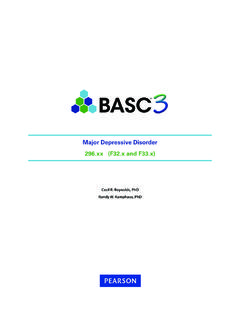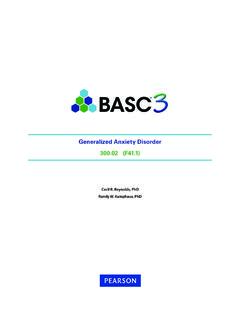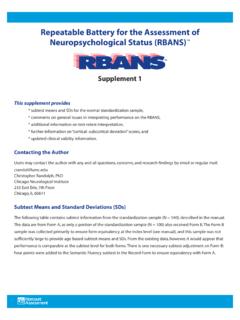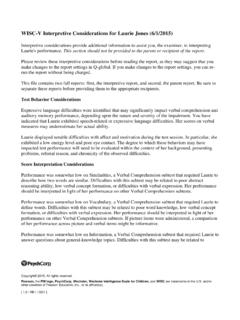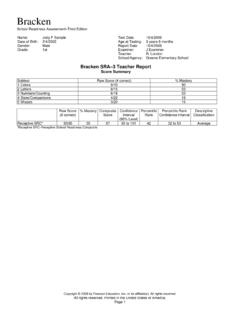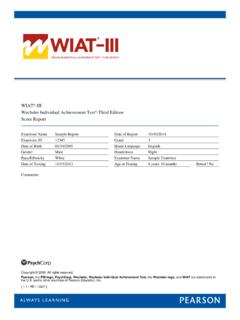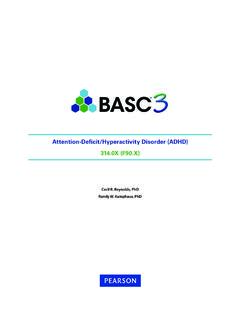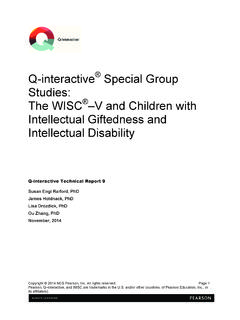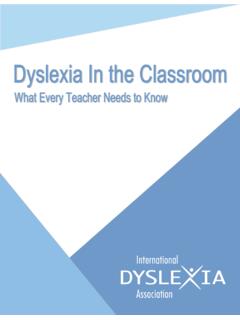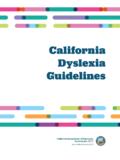Transcription of A Dyslexia Toolkit White Paper - images.pearsonclinical.com
1 MARCH 2019. Pearson Clinical Assessment Solutions: A Dyslexia Toolkit Kristina Breaux, PhD, Senior Research Director, Clinical Assessment Tina Eichstadt, MS CCC-SLP, Senior Product Manager, Clinical Assessment Pearson Clinical Assessment offers a Dyslexia Toolkit with resources for screening, identification, intervention, and progress monitoring. This report will be updated periodically as new tools become available. Up to 1-in-5 people exhibit symptoms of Dyslexia , SCREEN ASSESS. a very common language-based reading disorder. Although developing and implementing an evidence-based assessment and intervention plan is crucial, very often the most important factor is early identification.
2 Pearson's Dyslexia Toolkit includes clinical and classroom resources for screening, diagnostic evaluations, intervention, and progress monitoring. Included are tools that can be used across a wide range of professional groups and user qualification levels. MONITOR INTERVENE. INTERVENTION. Pearson's Dyslexia Toolkit SCREEN ASSESS INTERVENE MONITOR. Shaywitz DyslexiaScreen Kaufman Test of Educational Intervention Guide for LD Review360 for SLPs Achievement , Third Edition (Learning Disability) Subtypes (KTEA -3) Comprehensive Form Wide Range Achievement Test, Process Assessment of the Learner, Process Assessment of the aimswebPlus Fifth Edition (WRAT5 ) Second Edition : Diagnostics Learner (PAL ) reading and for Reading and Writing (PAL -II writing lessons Reading and Writing).
3 Kaufman Test of Educational Wechsler Individual Achievement KTEA-3 teaching objectives Growth Scale Value (GSV). Achievement , Third Edition Test , Third Edition (WIAT -III) and intervention statements Scores (KTEA -3) Brief Form WIAT-III intervention goal statements Dyslexia index scores from the Woodcock Reading Mastery Tests , SPELL-Links . KTEA-3 and WIAT -III Third Edition (WRMT -III) to Reading & Writing SPELL-Links Class links for Classrooms . Learn more at 2 | Pearson Clinical Assessment Solutions: A Dyslexia Toolkit When reviewing this White Paper , please consider the following important notes: Identifying individuals with L. ocal processes and procedures Each resource in this Toolkit Dyslexia is a multi-step, across the US (and globally) shows strong empirical evidence collaborative process.
4 Supporting vary greatly within the Dyslexia on its own. The power of a Toolkit individuals who are academically context. Tool choices, and each comes from understanding at-risk or who have Dyslexia is tool's appropriate use, must be the need for multiple tools and not a quick fix and may require considered carefully against the how they fit together to guide layers of effort from simple available scientific evidence and clear decision making, giving the accommodations to special best practices in educational and collective effort additional education intervention. clinical contexts. power. Clear data, a sufficient knowledge base, and team-based decision-making allow the best path forward.
5 Understanding Dyslexia The international Dyslexia association (IDA) established the following definition of Dyslexia in 2002, which has since been adopted by many federal and state agencies: Dyslexia is a specific learning disability that is and reduced reading experience that can impede neurobiological in origin. It is characterized by growth of vocabulary and background difficulties with accurate and/or fluent word recognition and by poor spelling and decoding In 2015 a unanimous Senate vote for the Cassidy- abilities. These difficulties typically result from a Mikulski Resolution (Resolution 275)32a called on deficit in the phonological component of language Congress, schools, and state and local educational that is often unexpected in relation to other agencies to recognize the significant educational cognitive abilities and the provision of effective implications of Dyslexia that must be addressed.
6 Classroom instruction. Secondary consequences Then in 2017 , the Senate voted unanimously as may include problems in reading comprehension part of the 28432b to establish the following definition of Dyslexia : Copyright 2019 NCS Pearson, Inc. All rights reserved. 3 | Pearson Clinical Assessment Solutions: A Dyslexia Toolkit Prevalence estimates suggest that up to 20% of (1) an unexpected difficulty in reading for an the population show symptoms of , 17. individual who has the intelligence to be a Dyslexia is a language-based reading disorder that much better reader; and (2) most commonly typically results in lifelong impact to an individual. caused by a difficulty in phonological processing Diagnosis of Dyslexia can be made through medical (the appreciation of the individual sounds of or educational processes.)
7 Spoken language), which affects the ability of an individual to speak, read, and spell, and often, Many professional and parent groups including the ability to learn a second parents, school and clinical psychologists, speech- language pathologists, educational diagnosticians, reading specialists, general and special education Both definitions refer to the unexpected nature teachers, school administrators, and government of Dyslexia , which is often revealed by an uneven stakeholders support individuals with Dyslexia in a cognitive profile in which basic skill deficits are variety of ways. Collaboration among these groups surrounded by a sea of strengths in areas such as is key to facilitating a productive, robust, evidence- reasoning, problem solving, vocabulary, and listening based assessment and intervention plan.
8 A Hybrid Model of Dyslexia Identification Implementing an evidence-based process for Dyslexia screening, identification, intervention, and progress monitoring is paramount to improving student outcomes. The tests and products recommended in this Toolkit are designed to be used most effectively within a comprehensive framework such as a hybrid model for Dyslexia identification. Approaches to identification that rely on a single criterion are prone to measurement error and show poor stability over , 20 In contrast, a hybrid model incorporates multiple sources of information, stability of classification over time, and signals that as well as the degree to which the student has the reading problem is persistent and not due to responded to treatment.
9 Students who do not inadequate , 38 The hybrid model shown respond to high quality instruction may be more in Figure 1 summarizes the symptoms, causes and likely to have an underlying cognitive deficit that correlates, and risk factors that may be considered manifests as Dyslexia . For this reason, incorporating as part of a Dyslexia evaluation. treatment response data as one essential criterion for Dyslexia reduces false positives, improves Copyright 2019 NCS Pearson, Inc. All rights reserved. 4 | Pearson Clinical Assessment Solutions: A Dyslexia Toolkit Symptoms Before the onset of formal schooling, parents or caregivers may observe early risk factors for Dyslexia .
10 For example, some children with Dyslexia begin speaking later than most other children, have 11 2 3 4 5. problems with pronunciation, or use vague terms because they have difficulty recalling the specific 234 5. word for an The symptoms of Dyslexia are most commonly observed at school or during reading and writing a number of other reasons such as intellectual tasks. Before learning to read, children with Dyslexia disability and socioemotional problems. may exhibit difficulties with alphabet writing, An individual with Dyslexia may not exhibit every letter identification, and/or phonics (letter-sound symptom at a given point in time, and his or her correspondence).
